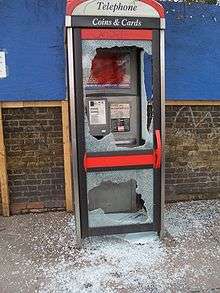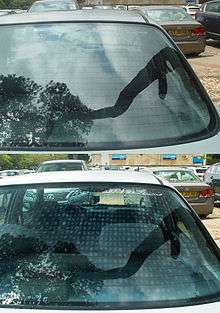Toughened glass

Toughened or tempered glass is a type of safety glass processed by controlled thermal or chemical treatments to increase its strength compared with normal glass. Tempering puts the outer surfaces into compression and the inner surfaces into tension. Such stresses cause the glass, when broken, to crumble into small granular chunks instead of splintering into jagged shards as plate glass (aka: annealed glass) creates. The granular chunks are less likely to cause injury.
As a result of its safety and strength, toughened glass is used in a variety of demanding applications, including passenger vehicle windows, shower doors, architectural glass doors and tables, refrigerator trays, mobile screen protectors, as a component of bulletproof glass, for diving masks, and various types of plates and cookware.
Properties

Toughened glass is physically and thermally stronger than regular glass. The greater contraction of the inner layer during manufacturing induces compressive stresses in the surface of the glass balanced by tensile stresses in the body of the glass. For glass to be considered toughened, this compressive stress on the surface of the glass should be a minimum of 69 megapascals (10,000 psi). For it to be considered safety glass, the surface compressive stress should exceed 100 megapascals (15,000 psi). The greater the surface stress, the smaller the glass particles will be when broken.
It is this compressive stress that gives the toughened glass increased strength. This is because any surface flaws tend to be pressed closed by the retained compressive forces, while the core layer remains relatively free of the defects which could cause a crack to begin.
Any cutting or grinding must be done prior to tempering. Cutting, grinding, and sharp impacts after tempering will cause the glass to fracture.
The strain pattern resulting from tempering can be observed with polarized light or by using a pair of polarizing sun glasses.
Uses
Toughened glass is used when strength, thermal resistance, and safety are important considerations.
Automobiles
The most commonly encountered tempered glass is that used for side and rear windows in automobiles.

It is used for its characteristic of shattering into small cubes rather than large shards and is sometimes referred to as safety glass in this context. (The windscreen or windshield is instead made of laminated glass, which will not shatter when broken.)
Buildings and structures
Toughened glass is also used in buildings for unframed assemblies (such as frameless glass doors), structurally loaded applications, and any other application that would become dangerous in the event of human impact. Tempered and heat strengthened glass can be three to seven times stronger than annealed glass.[1] Building codes in the United States require tempered or laminated glass in several situations including some skylights,[2] near doorways and stairways, large windows, windows which extend close to floor level, sliding doors, elevators, fire department access panels, and near swimming pools.
Food service
"Rim-tempered" indicates that a limited area, such as the rim of the glass or plate, is tempered and is popular in food service. However, there are also specialist manufacturers that offer a fully tempered/toughened drinkware solution that can bring increased benefits in the form of strength and thermal shock resistance. In some countries these products are specified in venues that require increased performance levels or have a requirement for a safer glass due to intense usage.
Tempered glass has also seen increased usage in bars and pubs, particularly in the United Kingdom and Australia, to prevent broken glass being used as a weapon.
Cooking and baking
Some forms of tempered glass are used for cooking and baking. Manufacturers and brands include Glasslock, Pyrex, Corelle, and Arc International.
Mobile Devices
Most touchscreen mobile devices use some form of toughened glass (such as Corning's Gorilla Glass[3]), as do some aftermarket screen protectors for these devices.[4]
Manufacturing
Toughened glass can be made from annealed glass via a thermal tempering process. The glass is placed onto a roller table, taking it through a furnace that heats it well above its transition temperature of 564 °C (1,047 °F) to around 620 °C (1,148 °F). The glass is then rapidly cooled with forced air drafts while the inner portion remains free to flow for a short time.
An alternative chemical toughening process involves forcing a surface layer of glass at least 0.1 mm thick into compression by ion exchange of the sodium ions in the glass surface with potassium ions (which are 30% larger), by immersion of the glass into a bath of molten potassium nitrate. Chemical toughening results in increased toughness compared with thermal toughening and can be applied to glass objects of complex shapes.[5]
Advantages
The term "toughened glass" is generally used to describe fully tempered glass but is sometimes used to describe heat-strengthened glass as both types undergo a thermal "toughening" process.
There are two main types of heat-treated glass: heat-strengthened and fully tempered. Heat-strengthened glass is twice as strong as annealed glass while fully tempered glass has typically four to six times the strength of annealed glass and withstands heating in microwave ovens. The difference is the residual stress in the edge and glass surface. Fully tempered glass in the US is generally rated above 65 megapascals (9,400 psi) in pressure-resistance, while heat-strengthened glass is between 40 and 55 megapascals (5,800 and 8,000 psi).
The tempering process does not change the stiffness of the glass. Annealed glass undergoes a similar deflection compared to tempered glass under the same load, but tempered glass can take a higher load and, therefore, deflects further before breaking.
Disadvantages
Toughened glass must be cut to size or pressed to shape before toughening, and cannot be re-worked once toughened. Polishing the edges or drilling holes in the glass is carried out before the toughening process starts. Because of the balanced stresses in the glass, damage to any portion will eventually result in the glass shattering into thumbnail-sized pieces. The glass is most susceptible to breakage due to damage to the edge of the glass, where the tensile stress is the greatest, but shattering can also occur in the event of a hard impact in the middle of the glass pane or if the impact is concentrated (for example, striking the glass with a hardened point).
Using toughened glass can pose a security risk in some situations because of the tendency of the glass to shatter completely upon hard impact rather than leaving shards in the window frame.[6]
The surface of tempered glass does exhibit surface waves caused by contact with flattening rollers, if it has been formed using this process. This waviness is a significant problem in manufacturing of thin film solar cells.[7] The float glass process can be used to provide low-distortion sheets with very flat and parallel surfaces.
History
Francois Barthelemy Alfred Royer de la Bastie (1830–1901) of Paris, France is credited with first developing a method of tempering glass[8] by quenching almost molten glass in a heated bath of oil or grease in 1874, the method patented in England on August 12, 1874, patent number 2783. Tempered glass is sometimes known as Bastie glass after de la Bastie. In 1877 the German Frederick Siemens developed a different process, sometimes called compressed glass or Siemens glass, producing a tempered glass stronger than the Bastie process by pressing the glass in cool molds.[9] The first patent on a whole process to make tempered glass was held by chemist Rudolph A. Seiden who was born in 1900 in Austria and immigrated to the United States in 1935.[10]
Though the underlying mechanism was not known at the time, the effects of "tempering" glass have been known for centuries. In about 1660, Prince Rupert of the Rhine brought the discovery of what are now known as "Prince Rupert's Drops" to the attention of King Charles II. These are teardrop-shaped bits of glass which are produced by allowing a molten drop of glass to fall into a bucket of water, thereby rapidly cooling it. They can withstand a blow from a hammer on the bulbous end without breaking, but the drops will disintegrate explosively into powder if the tail end is even slightly damaged.
See also
References
- ↑ Redner, A. S., "PC-Based Stress-Measuring System for On-Line Quality Control of Tempered and Heat-Strengthened Glass," Use of Glass in Buildings, ASTM STP 1434, V. Block, ed. ASTM International, West Conshohocken, PA 2002
- ↑ Hageman, Jack M., and Brian E. P. Beeston. Contractor's Guide to the Building Code. 6th ed. Carlsbad: Craftsman Book, 2008. 360. Print.
- ↑ List of devices with Gorilla Glass
- ↑ "PET, TPU, or Tempered Glass – all you need to know to choose a screen protector". phonearena.com.
- ↑ H.G. Pfaender (1996) Schott guide to glass. Chapman and Hall ISBN 0-412-62060-X
- ↑ O'Block, Robert L.; Donnermeyer, Joseph F.; Doeren, Stephen E. (1991). Security and Crime Prevention. Butterworth–Heinemann.
The security value of tempered glass, however, is questionable. Although it will resist a brick or rock, it is susceptible to sharp instruments such as ice picks or screwdrivers. When attacked in this manner, tempered glass tends to crumple easily and quietly, leaving no sharp edges.
- ↑ Walecki, W.; Szondy, F. (2008). "Integrated quantum efficiency, topography, and stress metrology for solar cell manufacturing: real space approach". Proc. SPIE. 7048: 704804. doi:10.1117/12.792934.
- ↑ "Glass." The Encyclopædia Britannica : A Dictionary of Arts, Sciences and General Literature. 9th ed. (American reprint). Vol. 10. Philadelphia: Sherman & co., 1894. 595. Print.
- ↑ Uhlmann, D.R. and Kreidl, N. J. eds.. Glass. Science and Technology: Elasticity and Strength in Glasses. Vol. 5. New York, N.Y.: Academic, 1980. 197. Print.
- ↑ Barr, Johathan. "The Glass Tempering Handbook: Understanding the Glass Tempering Process". Self published. http://www.lambertgtservices.co.uk/book/TheGlassTemperingHandbook.pdf accessed February 28, 2015
